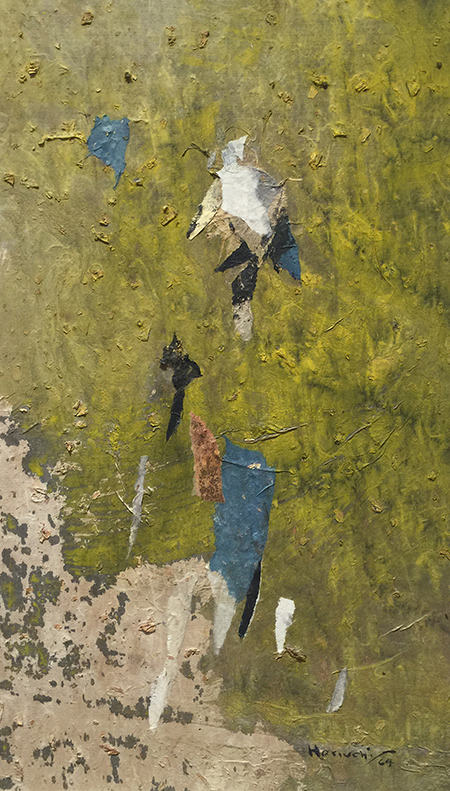
Continuing through October 24, 2015
This Paul Horiuchi survey is the latest of several posthumous gallery and museum exhibits since the Japanese-born artist’s death in 1999 at age 93. Closer to Mark Tobey in age than to the other Northwest School members Morris Graves, Kenneth Callahan and Guy Irving Anderson, Horiuchi (who was offered the “honor” of sweeping Tobey’s studio when they first met) was self-taught and had exhibited in California art museums during the 1930s and 1940s, long before his 1952 Zoe Dusanne Gallery debut in Seattle when he was grouped with three other Japanese-American artists (This was also the gallery where Yayoi Kusama and Sam Francis had their first U.S. shows). That year he was still painting in a representational style, but gradually switched to torn rice-paper, painted collages that incorporated antique Japanese woodcuts (he was co-owner of an Asian antiques shop).
These collages attracted the attention of David Rockefeller, among others, who reportedly bought out the entire New York debut show at Nordness in 1961. After that, a great deal of curatorial and critical attention followed, with the subsequent New York shows all covered respectfully in “The New York Times,” “Art in America,” “Art International,” “TIME,” and the “Christian Science Monitor.”
It was the blend of Japanese aesthetics — serenity, understatement, and careful composition — with rising Color Field and Hard-Edge painting that attracted collectors and critics in the wake of Mr. Rockefeller. Horiuchi unwittingly embodied both trends.
On view are some fine early works such as “Autumn Wind” (1964) and “First Light” (1965). Another, “Awareness of Time” (1964), was shown at the Smithsonian American Art Museum in 1974. Horiuchi was also in important surveys at the Carnegie Museum, Detroit Institute of Arts, and Pennsylvania Academy of Fine Arts and, beginning in 1956, in Tokyo, then later, in Osaka, Kobe, and Kyoto, culminating in a 2003 retrospective at Yamanashi Museum in Horiuchi’s hometown of Kawaguchiko. Japanese art historians began assiduously transcribing the calligraphy on the collaged woodcuts (as Picasso scholars scrutinized those French newspaper fragments in the first cubist paintings) only to conclude they were often upside-down and mostly used for formal and decorative effect. The Museum of Northwest Art in La Conner, Washington mounted “Paul Horiuchi: East and West” in 2008, the largest retrospective to date. Museums in the Northwest have substantial holdings that are paralleled in other art museums in Great Britain, Canada, New York, Arizona, Tennessee and Massachusetts.
“Winter Landscape, Wyoming” (1979), “Tales of the Past” (1970), and “Winter Reeds” (1981) mark an abrupt if temporary detour to representational imagery before the substantial glories of such sublime abstractions as “Composition with Vertical” (1987) and “Warm Silence” (no date).
Known for muted colors akin to those of Tobey and his cohorts, the new survey stresses the chromatic variety and range of Horiuchi although most works operate within a carefully modulated palette to make their points. Several folding screens, including “Colors and Words from the Past III” (1975) and “Remnants and Segments of Antiquity II” (n.d.), are mounted flat against the wall. It would be nice to see them displayed freestanding in order to better appreciate their Japanese context, gracious formality, as well as to see how Horiuchi moved from section to section within each screen.
It’s funny to read how West Coast art critics stressed the Asian ties of Horiuchi while East Coast writers compared him to Conrad Marca-Relli, Helen Frankenthaler, Robert Goodnough and Raymond Parker, all second-wave abstract expressionists or proto-Color Field painters. Sharing Frankenthaler’s occasional palette of pink, green, orange and dark blue, Horiuchi appealed at the time to those in search of a less gestural abstraction that was still quietly animated.
What Horiuchi did not share with the New Yorkers was the Big Canvas. Except for one work, the 1962 World’s Fair “Seattle Mural,” a huge glass mosaic the construction of which he oversaw on Murano Island near Venice, Italy. This work demonstrated the artist's total command of all-over, centerless composition. Horiuchi’s preference, however, was for an intimate encounter of scale. The viewer is not confronted by, but rather invited into the elegant and somber mood of each picture. No wonder the New Yorkers were stunned when he first took on the Big Apple.
